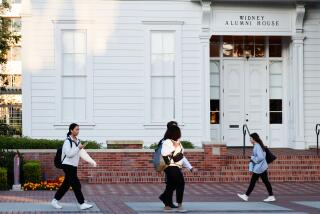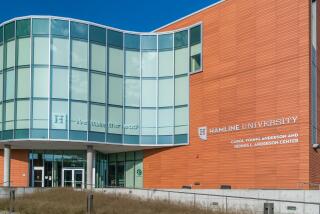High Court Denies Plea to Pull Muhammad Art
- Share via
WASHINGTON — Chief Justice William H. Rehnquist on Wednesday denied a request by a coalition of 16 Muslim groups to remove a bas-relief of Muhammad from the wall of the courtroom where the U.S. Supreme Court meets, which Muslims complained denigrated their prophet.
The 7th century religious leader is shown as one among a pantheon of 18 great lawgivers of history represented on the courtroom walls.
The coalition cited Islamic tradition that discourages artistic portrayals of Muhammad to prevent idolatry and also objected to showing him wielding a sword, which they contended feeds stereotypical images of Islam as a violent faith.
In a 250-word letter faxed to the Washington-based Council on American-Islamic Relations, Rehnquist said the depiction of Muhammad in the 64-year-old frieze was “intended only to recognize him, among many other lawgivers, as an important figure in the history of law; it is not intended as a form of idol worship.”
Altering the stone carving would “impair the artistic integrity of the whole,” Rehnquist said, adding it would even be unlawful to remove or alter an architectural feature of the building.
To coalition protests against showing Muhammad with a sword, Rehnquist replied: “I would point out that swords are used throughout the court’s architecture as a symbol of justice; for example, nearly a dozen swords appear in the courtroom friezes alone, and one is featured in the large statue entitled, ‘The Authority of Law,’ in front of the building.”
The chief justice’s comment on sword symbolism echoed a dissenting statement issued March 1 by the Muslim Women Lawyers for Human Rights, based in Richmond, Va., which asked court administrators not to alter the depiction of Muhammad.
Azizah Al-Hibri, executive director of the Muslim women lawyers’ group, also said Islamic cultures have tolerated artistic renditions of Muhammad in Persian and Turkish art. Abdu Alamoudi of the American Muslim Council also supported the women lawyers’ position.
Although the bas-relief carving of Muhammad has been in place since 1933, Muslim activists had noticed it only last December.
The Council on American-Islamic Relations and other groups, including the Los Angeles-based Muslim Public Affairs Council, quietly asked administrative officials of the Supreme Court in January and February whether the Muhammad portion of the frieze could be altered or removed.
In late February, James C. Duff, administrative assistant to the chief justice, informed the coalition and Al-Hibri that changes would be made to improve wording on court souvenirs and brochures that describe Muhammad’s appearance on the frieze.
Rehnquist’s letter gave the substitute wording, using the preferred spelling of Qur’an (instead of Koran) for the book “that Muslims believe is the divine word of God which was revealed to Muhammad,” the chief justice wrote.
The new wording notes in parentheses: “The above figure is a well-intentioned attempt by the sculptor Adolph Weinman to honor Muhammad and it bears no resemblance to Muhammad.”
Nihad Awad, executive director of the Council on American-Islamic Relations, said, “We appreciate the court’s willingness to change the language in its literature . . . but the main issue, that of the Prophet’s image, remains unresolved.”
Awad said other coalition groups would be consulted before deciding on any future steps.
But Salam Al-Marayati of Glendale, director of the Muslim Public Affairs Council, said Rehnquist’s decision is “something we have to accept.” He expressed appreciation for the court’s sensitivity to Muslim feelings in modifying the souvenir brochures.
More to Read
Sign up for Essential California
The most important California stories and recommendations in your inbox every morning.
You may occasionally receive promotional content from the Los Angeles Times.










